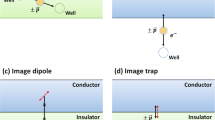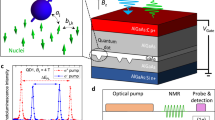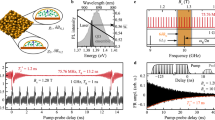Abstract
A huge effort is underway to develop semiconductor nanostructures as low-noise qubits. A key source of dephasing for an electron spin qubit in GaAs and in naturally occurring Si is the nuclear spin bath. The electron spin is coupled to each nuclear spin by the hyperfine interaction. The same interaction also couples two remote nuclear spins via a common coupling to the delocalized electron. It has been suggested that this interaction limits both electron and nuclear spin coherence, but experimental proof is lacking. We show that the nuclear spin decoherence time decreases by two orders of magnitude on occupying an empty quantum dot with a single electron, recovering to its original value for two electrons. In the case of one electron, agreement with a model calculation verifies the hypothesis of an electron-mediated nuclear spin–nuclear spin coupling. The results establish a framework to understand the main features of this complex interaction in semiconductor nanostructures.
This is a preview of subscription content, access via your institution
Access options
Subscribe to this journal
Receive 12 print issues and online access
$259.00 per year
only $21.58 per issue
Buy this article
- Purchase on Springer Link
- Instant access to full article PDF
Prices may be subject to local taxes which are calculated during checkout




Similar content being viewed by others
References
Loss, D. & DiVincenzo, D. P. Quantum computation with quantum dots. Phys. Rev. A 57, 120–126 (1998).
Chekhovich, E. A. et al. Nuclear spin effects in semiconductor quantum dots. Nature Mater. 12, 494–504 (2013).
Petta, J. R. et al. Coherent manipulation of coupled electron spins in semiconductor quantum dots. Science 309, 2180–2184 (2005).
Reilly, D. J. et al. Suppressing spin qubit dephasing by nuclear state preparation. Science 321, 817–821 (2008).
Shulman, M. D. et al. Suppressing qubit dephasing using real-time Hamiltonian estimation. Nature Commun. 5, 5156 (2014).
Bluhm, H. et al. Dephasing time of GaAs electron-spin qubits coupled to a nuclear bath exceeding 200 μs. Nature Phys. 7, 109–113 (2011).
Witzel, W. M. & Sarma, S. D. Multiple-pulse coherence enhancement of solid state spin qubits. Phys. Rev. Lett. 98, 077601 (2007).
Cywiński, L., Witzel, W. M. & Das Sarma, S. Electron spin dephasing due to hyperfine interactions with a nuclear spin bath. Phys. Rev. Lett. 102, 057601 (2009).
Klauser, D., Coish, W. A. & Loss, D. Nuclear spin dynamics and Zeno effect in quantum dots and defect centers. Phys. Rev. B 78, 205301 (2008).
Khaetskii, A. V., Loss, D. & Glazman, L. Electron spin decoherence in quantum dots due to interaction with nuclei. Phys. Rev. Lett. 88, 186802 (2002).
Yao, W., Liu, R.-B. & Sham, L. J. Theory of electron spin decoherence by interacting nuclear spins in a quantum dot. Phys. Rev. B 74, 195301 (2006).
Hanson, R., Kouwenhoven, L. P., Petta, J. R., Tarucha, S. & Vandersypen, L. M. K. Spins in few-electron quantum dots. Rev. Mod. Phys. 79, 1217–1265 (2007).
Coish, W. A., Fischer, J. & Loss, D. Free-induction decay and envelope modulations in a narrowed nuclear spin bath. Phys. Rev. B 81, 165315 (2010).
Faribault, A. & Schuricht, D. Integrability-based analysis of the hyperfine-interaction-induced decoherence in quantum dots. Phys. Rev. Lett. 110, 040405 (2013).
Kondo, Y. et al. Multipulse operation and optical detection of nuclear spin coherence in a GaAs/AlGaAs quantum well. Phys. Rev. Lett. 101, 207601 (2008).
Chekhovich, E. A., Hopkinson, M., Skolnick, M. S. & Tartakovskii, A. I. Suppression of nuclear spin bath fluctuations in self-assembled quantum dots induced by inhomogeneous strain. Nature Commun. 6, 6348 (2015).
Reilly, D. J. et al. Exchange control of nuclear spin diffusion in a double quantum dot. Phys. Rev. Lett. 104, 236802 (2010).
Warburton, R. J. et al. Optical emission from a charge-tunable quantum ring. Nature 405, 926–929 (2000).
Urbaszek, B. et al. Nuclear spin physics in quantum dots: an optical investigation. Rev. Mod. Phys. 85, 79–133 (2013).
Munsch, M. et al. Manipulation of the nuclear spin ensemble in a quantum dot with chirped magnetic resonance pulses. Nature Nanotech. 9, 671–675 (2014).
Chekhovich, E. A. et al. Structural analysis of strained quantum dots using nuclear magnetic resonance. Nature Nanotech. 7, 646–650 (2012).
Bulutay, C., Chekhovich, E. A. & Tartakovskii, A. I. Nuclear magnetic resonance inverse spectra of InGaAs quantum dots: atomistic level structural information. Phys. Rev. B 90, 205425 (2014).
Kloeffel, C. et al. Controlling the interaction of electron and nuclear spins in a tunnel-coupled quantum dot. Phys. Rev. Lett. 106, 046802 (2011).
Warburton, R. J. Single spins in self-assembled quantum dots. Nature Mater. 12, 483–493 (2013).
Kuhlmann, A. V. et al. Charge noise and spin noise in a semiconductor quantum device. Nature Phys. 9, 570–575 (2013).
Kuhlmann, A. V. et al. A dark-field microscope for background-free detection of resonance fluorescence from single semiconductor quantum dots operating in a set-and-forget mode. Rev. Sci. Instr. 84, 073905 (2013).
Latta, C. et al. Confluence of resonant laser excitation and bidirectional quantum-dot nuclear-spin polarization. Nature Phys. 5, 758–763 (2009).
Van Veenendaal, E., Meier, B. & Kentgens, A. Frequency stepped adiabatic passage excitation of half-integer quadrupolar spin systems. Mol. Phys. 93, 195–213 (1998).
Smith, J. M. et al. Voltage control of the spin dynamics of an exciton in a semiconductor quantum dot. Phys. Rev. Lett. 94, 197402 (2005).
Dreiser, J. et al. Optical investigations of quantum dot spin dynamics as a function of external electric and magnetic fields. Phys. Rev. B 77, 075317 (2008).
Kroner, M. et al. Resonant two-color high-resolution spectroscopy of a negatively charged exciton in a self-assembled quantum dot. Phys. Rev. B 78, 075429 (2008).
Maletinsky, P., Badolato, A. & Imamoglu, A. Dynamics of quantum dot nuclear spin polarization controlled by a single electron. Phys. Rev. Lett. 99, 056804 (2007).
Paget, D., Lampel, G., Sapoval, B. & Safarov, V. I. Low field electron-nuclear spin coupling in gallium arsenide under optical pumping conditions. Phys. Rev. B 15, 5780–5796 (1977).
Coish, W. A. & Baugh, J. Nuclear spins in nanostructures. Phys. Status Soldi B 246, 2203–2215 (2009).
Press, D. et al. Ultrafast optical spin echo in a single quantum dot. Nature Photon. 4, 367–370 (2010).
Acknowledgements
R.J.W., M.P. and D.L. acknowledge support from NCCR QSIT; R.J.W. and D.L. from EU ITN S3NANO; R.J.W. from SNF project 200020_156637; M.P. from the SNI; and A.L. and A.D.W. from Mercur Pr-2013-0001 and BMBF-Q.com-H 16KIS0109.
Author information
Authors and Affiliations
Contributions
G.W. and M.M. carried out the experiments, the data analysis and the theoretical modeling under the guidance of M.P. and R.J.W.; F.M. conducted the theoretical analysis under the guidance of D.L.; A.V.K. provided expertise in resonance fluorescence on single quantum dots; A.L. and A.D.W. carried out the molecular beam epitaxy. G.W., M.M., F.M. and R.J.W. took the lead in writing the paper and the Supplementary Information. R.J.W. managed the project.
Corresponding author
Ethics declarations
Competing interests
The authors declare no competing financial interests.
Supplementary information
Supplementary information
Supplementary information (PDF 1216 kb)
Rights and permissions
About this article
Cite this article
Wüst, G., Munsch, M., Maier, F. et al. Role of the electron spin in determining the coherence of the nuclear spins in a quantum dot. Nature Nanotech 11, 885–889 (2016). https://doi.org/10.1038/nnano.2016.114
Received:
Accepted:
Published:
Issue Date:
DOI: https://doi.org/10.1038/nnano.2016.114
This article is cited by
-
Harnessing many-body spin environment for long coherence storage and high-fidelity single-shot qubit readout
Nature Communications (2022)
-
Quantum sensing of a coherent single spin excitation in a nuclear ensemble
Nature Physics (2021)
-
Witnessing quantum correlations in a nuclear ensemble via an electron spin qubit
Nature Physics (2021)
-
Semiconductor qubits in practice
Nature Reviews Physics (2021)
-
Suppression of nuclear spin fluctuations in an InGaAs quantum dot ensemble by GHz-pulsed optical excitation
npj Quantum Information (2021)



